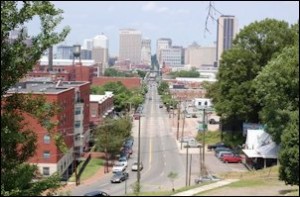Richmond Mayor Dwight C. Jones has doubled down on his proposal to build a minor league baseball stadium in Shockoe Bottom, suggesting that people opposing his plan are “anti-growth and anti-economic development,” according to the Times-Dispatch. I can’t speak for other skeptics of the plan, but I’m certainly not anti-growth or anti-economic development. To the contrary, I simply question whether the $80 million that Jones proposes to spend on the stadium and supporting infrastructure is the best way for the city to invest scarce public resources.
I’m not “anti-growth”; I just have a different vision for growth. Jones hews to the old model of urban revitalization, which the City of Richmond has pursued with mixed success for decades, based upon the supposition that grandiose projects such as athletic stadiums, convention centers and glitzy retail centers can act as magnets to lure affluent people and their tax dollars back to the city center. I subscribe to the idea that the City of Richmond should foster the evolution of its downtown and surrounding neighborhoods into what Brookings Institution scholars Bruce Katz and Julie Wagner call “innovation districts.”
In a recent column, they describe the economic forces at work:
Once upon a time, innovation was an isolationist sport. In America’s innovative economy 20 years ago, a worker drove to a nondescript office campus along a suburban corridor, worked in isolation, and kept ideas secret.
Today, by contrast and partly a result of the Great Recession, proximity is everything. Talented people want to work and live in urban places that are walkable, bike-able, connected by transit, and hyper-caffeinated. Major companies across multiple sectors are practicing “open innovation” and want to be close to other firms, research labs, and universities. Entrepreneurs want to start their companies in collaborative spaces, where they can share ideas and have efficient access to everything from legal advice to sophisticated lab equipment.
These disruptive forces are coming to ground in small, primarily urban enclaves—what we and others are calling “innovation districts.” By our definition, innovation districts cluster and connect leading-edge institutions with startups and spin-off companies, business incubators, and accelerators in the relentless pursuit of cutting-edge discoveries for the market. Compact, transit-accessible, and highly networked, they grow talent, foster open collaboration, and offer mixed-used housing, office, retail, and 21st century urban amenities. In many respects, the rise of innovation districts embodies the very essence of cities: an aggregation of talented, driven people assembled in close quarters, who exchange ideas and knowledge. It’s in the vein of what urban historian Sir Peter Hall calls “a dynamic process of innovation, imitation and improvement.”
Richmond’s urban core is an emerging innovation district that encompasses the traditional downtown, Virginia Commonwealth University, Shockoe Bottom and the Manchester neighborhood across the James River. This district possesses everything that Katz and Wagner describe: a research university; a walkable, bikable urban environment served by mass transit; an increasing supply of downtown housing, and access to high-end professional services. It also has access to inexpensive commercial real estate for start-ups, a criteria cited by urbanist Jane Jacobs in her classic, “The Death and Life of Great American Cities.” A baseball stadium adds nothing to this mix.
Unlike efforts to grow the “consumer city” via sports stadia, luxury housing, and high-end retail, innovation districts are intent on growing the firms, networks, and sectors that drive real, broad-based prosperity.
At a time of increasing concerns over inequality and resilience, innovation districts can spur productive, inclusive, and sustainable growth. If properly structured and scaled, they can provide a strong foundation for the commercialization of ideas, the expansion of firms, and the creation of jobs. They also offer the tantalizing prospect of expanding employment and educational opportunities for disadvantaged populations—many innovation districts are close to low- and moderate-income neighborhoods—as well as sparking more sustainable development patterns, given their embrace of transit, historic buildings, traditional street grids, and existing infrastructure.
Jones has been supportive of investing in Richmond’s bicycling infrastructure and promoting the James River parks system, which appeal to the creative-class types who frequent downtown. Embracing the innovation-district concept should not be a big stretch for him. But if he’s truly interested in economic development — creating new business enterprises and new jobs — as opposed to steering commercial development from one location to another, he could get a lot more mileage for a lot less money by supporting Richmond’s home-grown innovation district.



